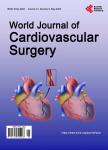Hemodynamic Changes and Clinical Outcomes after the Intra/Extracardiac Fenestrated Fontan Procedure
Hemodynamic Changes and Clinical Outcomes after the Intra/Extracardiac Fenestrated Fontan Procedure作者机构:Drexel University College of Medicine and Department of Pediatric Cardiothoracic Surgery St. Christopher’s Hospital for Children Philadelphia PA USA
出 版 物:《World Journal of Cardiovascular Surgery》 (心血管外科国际期刊(英文))
年 卷 期:2018年第8卷第2期
页 面:29-39页
学科分类:1002[医学-临床医学] 100214[医学-肿瘤学] 10[医学]
主 题:Fontan Functionally Univentricular Heart Circulatory Hemodynamics Hypoplastic Left Heart Syndrome Congenital Heart Disease (CHD)
摘 要:Background: The primary concern of the Fontan procedure has been atrial arrhythmias, but little attention has been given to hemodynamic changes. This study’s purpose was to examine the hemodynamics and arrhythmias of the Intra/extracardiac fenestrated Fontan, and determine any advantages/disadvantages of this newer Fontan procedure. Methods: Patients undergoing the intra/ extracardiac fenestrated Fontan procedure at this institute between December 2009 and June 2017 were included in this retrospective evaluation of preoperative and postoperative hemodynamics during cardiac catheterization. End Diastolic Pressure (EDP), Pulmonary Artery Pressure (PAP), Left Atrial Pressure (LAP), and Transpulmonary Gradient (TPG) were the hemodynamic markers of interest. Occurrence of arrhythmias was also examined preoperatively, less than 2 weeks postoperatively, and greater than 2 weeks postoperatively. Morbidities and mortalities were also evaluated. Results: Fourteen patients underwent the procedure between December 2009 and June 2017. Preoperative data was available in all of these patients. Postoperative data was partially incomplete for atrial arrhythmias and hemodynamic data. EDP rose from 9.29 ± 3.50 mmHg to 10.33 ± 3.12 mmHg. PAP rose from 12.57 ± 2.50 mmHg to 14.27 mmHg. TPG dropped from 5.00 ± 2.29 mmHg to 3.25 ± 1.67 mmHg. LAP rose from 7.57 ± 2.87 mmHg to 10.30 ± 1.95 mmHg. Atrioventricular valve (AVV) regurgitation remained the same pre and postoperatively. 8 of 13 patients developed arrhythmias at less than 2 weeks postoperatively, and 5 of 12 patients developed arrhythmias at greater than 2 weeks postoperatively. There were no morbidities or mortalities. Conclusions: We found a statistically significant change in EDP, PAP, LAP, and TPG levels. It is unclear whether this is an advantage or disadvantage. The significance of these changes is unclear in this small population of patients. Further evaluation of hemodynamics, arrhythmias, morbidities and mortalities associa



